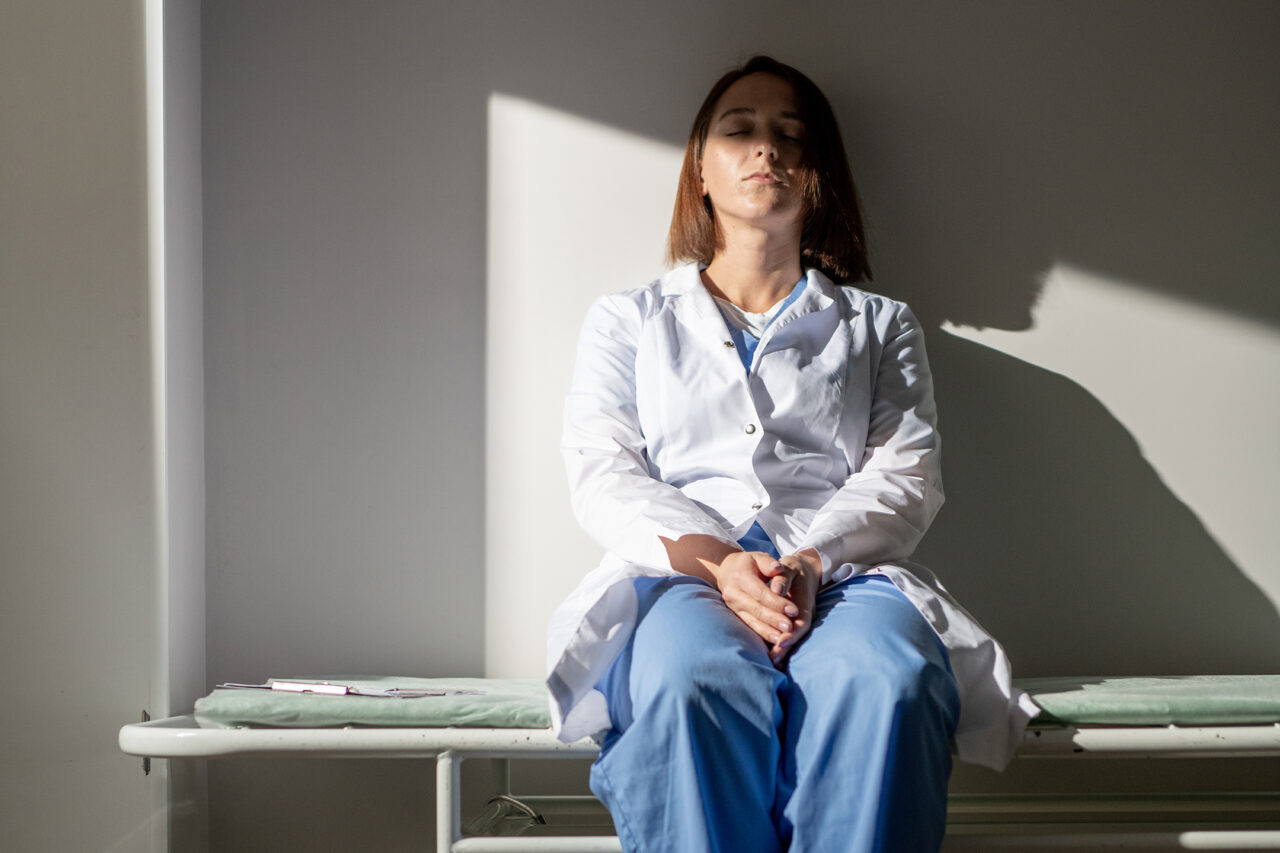 BY A. Kevin Troutman, Partner, Fisher Phillips, and Jessica Harrell, Ph.D., Cell & Developmental Biology
BY A. Kevin Troutman, Partner, Fisher Phillips, and Jessica Harrell, Ph.D., Cell & Developmental Biology
Even as people continue to get fully vaccinated and federal agencies such as the Centers for Disease Control and Prevention (CDC) and the Occupational Safety and Health Administration (OSHA) relax guidance about them, the fight against COVID-19 is far from over. Continuing to increase vaccination rates, especially among healthcare workers, remains a critical step toward enabling everyone, including employers, to resume pre-pandemic activities. The COVID-19 vaccines are a safe and effective way to 

Healthcare employers, in particular, still face substantial challenges in navigating the pandemic’s twists and turns. To maintain the highest level of care, providers must first hold a safe and healthy workforce, trained, protected, and equipped with all necessary personal protective equipment (PPE). Safety also drives policy decisions regarding visitation practices, distancing and communal activities, work restrictions, and quarantining and testing. As recent events demonstrate, higher vaccine rates seem to correlate with fewer severe cases, fewer extraordinary demands on the healthcare system, and a quicker return to pre-pandemic activities of daily living. To maintain this positive momentum, it remains essential to keep increasing the fully vaccinated population, especially among healthcare workers.
Warning: Undefined variable $posClass in /home1/mjhnewsc/public_html/wp-content/plugins/ap-plugin-scripteo/lib/functions.php on line 1078
When the CDC broadly relaxed masking and distancing recommendations for the fully vaccinated last month, allowing them to stop masking and social distancing, its guidance did not change existing laws or requirements. (Significantly, the CDC’s May 13
announcement expressly excluded applicability to healthcare settings and did not eliminate precautions for the unvaccinated.) OSHA, local, and other jurisdictions still determine what precautions are applicable in various settings and locations, including the workplace. Thus, for example, states continue to adjust requirements and thresholds regarding COVID-19 precautions. Similarly, among companies, some dropped masking requirements for customers and employees. Others eliminated masking only for customers while asking them to respect applicable CDC guidance. Some also dropped precautions for employees, but only those who provide proof of vaccination. Still, others relied on an honor system regarding who is or is not vaccinated. Each option presents both benefits and risks.
Warning: Undefined variable $posClass in /home1/mjhnewsc/public_html/wp-content/plugins/ap-plugin-scripteo/lib/functions.php on line 1078
As a result, healthcare workers now live in an environment where they may be more likely to come into close contact with unvaccinated people who are unmasked and not practicing social distancing while dining, shopping, or going to church. These locations rely on the honor system to determine the vaccinated and unvaccinated and should therefore be masking. Does anyone believe that all of those unmasked people are vaccinated?
Warning: Undefined variable $posClass in /home1/mjhnewsc/public_html/wp-content/plugins/ap-plugin-scripteo/lib/functions.php on line 1078
In short, science, statistics, and logic all indicate that healthcare workers should get vaccinated. CDC Director, Dr. Rochelle Walensky, stated that few vaccinated people become infected with the virus; transmission from them seems rare, and the vaccines appear to be effective on known COVID-19 variants. These critical comments support the increasingly probable hope that vaccinated people are doubtful to transmit the virus to others.
On the other hand, even when masked, an unvaccinated person is not nearly well-protected against COVID-19. Again, this illustrates the importance of encouraging the population, especially among healthcare workers, to get vaccinated.
Time also remains of the essence because as long as there are unvaccinated individuals, the virus has more chances to mutate into forms that may resist current vaccines or therapeutics. Yet, millions of adults have received only the first of a two-dose series, meaning they are not fully vaccinated (or protected). Additionally, data shows at least one-fifth of adults are dead set against being vaccinated. Others remain hesitant, meaning that one-third or more of the adult population is currently not ready and willing to be inoculated. Still, others have legitimate medical or religious reasons for declining ever to be vaccinated.
So even though roughly half of the nation’s adult population is fully vaccinated, there is still a long way to go to stop the spread of the virus. Meanwhile, healthcare workers continue to care for the sick and vulnerable, including COVID-19 patients.
Beyond some who are requiring vaccines, many Texas healthcare employers have already provided much-needed information, dispelling unfounded rumors and generally helping employees understand why getting vaccinated is the right choice among those responsible for the well-being of patients. These providers have also made vaccines readily available.
However, additional misinformation and misunderstandings remain, some of which can be readily addressed and hopefully negated in the critical march toward an end to the pandemic. Newer or nagging questions include:
I am worried about side effects – do I need a second dose?
Data from clinical trials and the real world indicate that side effects from the vaccine are mild and short-lived, especially compared to the long-lasting effects seen in patients that have been diagnosed with Covid-19. Many pre-Covid vaccines require a second dose – MMR, HepA, HepB, and shingles, for example. The second dose gives an additive effect to the ability of the immune system to respond to an infection. Data examined from the clinical trials and the real world for the Covid-19 vaccine demonstrate an even further reduction in hospitalizations and death in patients who received two doses than those who only received one dose.
Why should I get vaccinated if I can still transmit the virus?
Studies are still ongoing to understand the transmission of the virus among vaccinated people. However, scientists do know that severe disease and hospitalization occurrences are reduced significantly in fully vaccinated individuals.
Doesn’t the vaccine only protect the recipient, but not others? If so, why should I take it?
The vaccine helps to protect everyone. The more people that receive it, the less opportunity the virus will transmit throughout the population.
The less transmission of the virus we have, the less likely the virus will mutate as it passes between individuals.
Isn’t this vaccine still experimental?
mRNA vaccines have been in development for many years before the Covid-19 pandemic. Without overlooking scientific steps, the vaccine has been thorough a standard safety testing, including Phases I – III of a clinical trial, and found to be safe and effective. Under emergency conditions, such as during this pandemic, the manufacturer can apply for Emergency Use Authorization (EUA) by the FDA, a regulatory pathway to allow for this vaccine during an emergency. The EUA allows the company to produce and distribute the vaccine while simultaneously applying for full FDA approval instead of waiting for full permission to begin manufacturing and distributing the vaccine. EUA’s help to get the vaccine to the population faster to address the emergent need to stop the high rate of transmissions and infections of the virus.
Can a pregnant woman safely take the vaccine?
Clinical trials for the Covid-19 vaccine are ongoing in pregnant women. Preliminary data in pregnant women who have had the vaccine do not indicate any safety concerns. However, data from pregnant women who have contracted SARS-CoV-2 demonstrate they are at increased risk for severe illness than non-pregnant women and have a higher chance of adverse pregnancy outcomes than pregnant women who have not contracted the virus.
Can I “shed” the virus or dangerous spike proteins because I am vaccinated?
Each of the vaccines delivers material to the body’s cells that instruct it to make only a piece of the virus, specifically the spike protein like the ones covering the virus’s surface. The vaccine particles are then destroyed by the body quickly and cannot transmit to another person. Furthermore, the spike protein made by the vaccine does not cause disease itself, and it will not be shed by someone that is vaccinated. The vaccine does not contain any other parts of the virus, so a vaccinated person can’t shed the virus from the vaccine.
For additional in-depth information, the CDC website is regularly updated with answers to FAQs as we learn more: https://www.cdc.gov/coronavirus/2019-ncov/vaccines/about-vaccines/index.html
In sum, this battle is not over, and precautions remain in effect for the unvaccinated. Thus, for everyone who understands what science has revealed, this is no time to throw caution to wind. t
***On June 10, 2021, OSHA issued an Emergency Temporary Standard. The following language was included in the preamble to that Standard: Based on CDC guidance and the best available evidence, OSHA finds a grave danger in healthcare for vaccinated and unvaccinated HCP involved in the treatment of COVID-19 patients.



